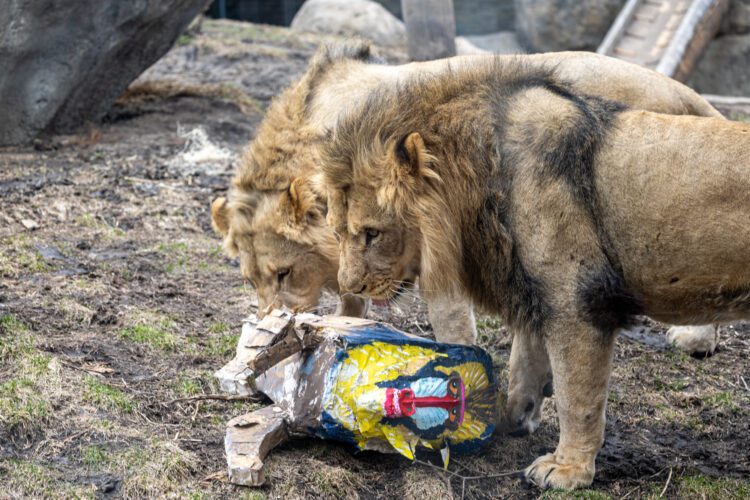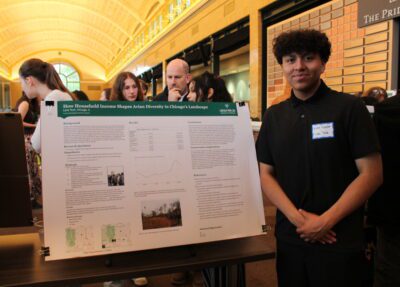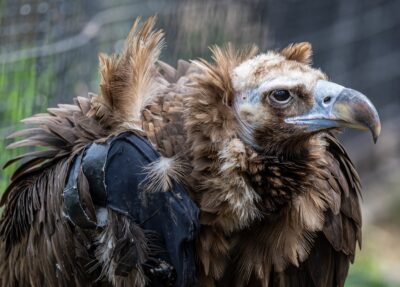State-of-the-art care is given to every single one of the more than 700 individual animals that live at Lincoln Park Zoo. This involves huge multidisciplinary collaboration: Animal keepers offer daily care; expert vets ensure the health of every individual; Nutrition staff distribute thousands of pounds of fish, lettuce, insects, hay, and more to habitats; and the Animal Welfare Science Program works to evaluate and enhance animal wellbeing. So much happens daily at the zoo!
But food, medical care, and shelter aren’t the only basics that zoo animals need—they also benefit from daily enrichment. Enrichment can consist of changes made to part of the animal’s habitat (like a change in the substrate), or it can be provided by keepers (like enrichment devices or scents). Enrichment is designed to help animals practice and learn species-specific behaviors.
Enrichment at Lincoln Park Zoo
At Lincoln Park Zoo, enrichment items are always thoughtfully considered and approved by multiple experts for each species. In fact, Lincoln Park Zoo has a dedicated Behavioral Husbandry Program, which has as its goal to improve the physical and psychological wellbeing of the animals in our care by using behavioral science and enrichment.
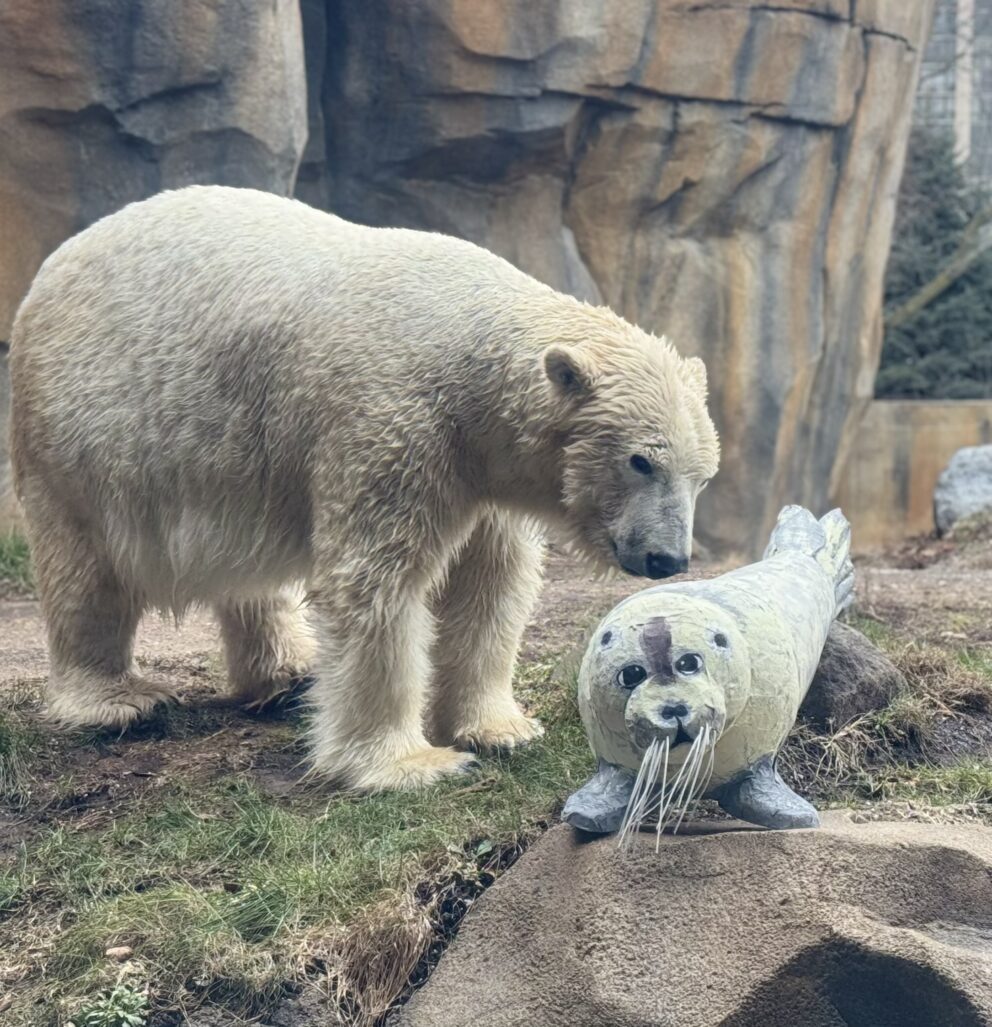
This image of polar bear Talini shows a pinata made by the Volunteer Enrichment Group. Enrichment like this papier-mache item can take multiple work sessions of several hours each to create—and then the animal may destroy it in just a few minutes! Photo credit: Lead Keeper of Carnivores Jill Dignan
Enrichment is considered a vital part of the proactive management of each individual—it’s no afterthought. “We think through what specific behaviors look like,” says Amanda Barnes, associate behavioral husbandry and enrichment manager. “Not just ‘what do I need,’ but ‘what can I add to this environment to make sure it has complexity?’ How do we improve the environment to give the animals opportunities? It requires a lot of collaboration to analyze how we accomplish those goals.” Of course, every animal is different, and staff work to meet the specific needs of each one.
Keepers create enrichment goals based on an animal’s natural history and then determine what specific behaviors will help animals achieve those goals. For example, in 2017 staff determined the pygmy hippos needed more foraging time and decided to build belt feeders that would distribute food to random parts of the habitat at different times.
Then, Veterinary Staff approve everything from substrates to the materials used based on safety considerations. As it’s being used, enrichment is also evaluated to ensure it is helping animals meet the set goals. In the case of the pygmy hippos, staff monitored their behavior with the belt feeders using the ZooMonitor app and determined the animals’ activity levels went up by 15%.
If items aren’t purchased (see the zoo’s Wish List!), they must be created. For more complicated items, the zoo’s Facilities staff may be called in to do the work. For most enrichment, though, the zoo turns to the Volunteer Enrichment Group for some skillful and enthusiastic help.
How It’s Made: A Little Help from the VEG
To assist zoo staff in creating novel enrichment items on a year-round basis, there’s a dedicated corps of around 27 volunteers known as the Volunteer Enrichment Group. These volunteers come once a week on either Tuesdays and Saturdays to engage in some hands-on crafting for several hours each session. They’re an important part of a community that is the cornerstone of the enrichment operation.
The VEG, as they’re affectionally called on-grounds, do everything from making zebra pinatas for the lions to weaving together fire hoses to create feeders and mats.
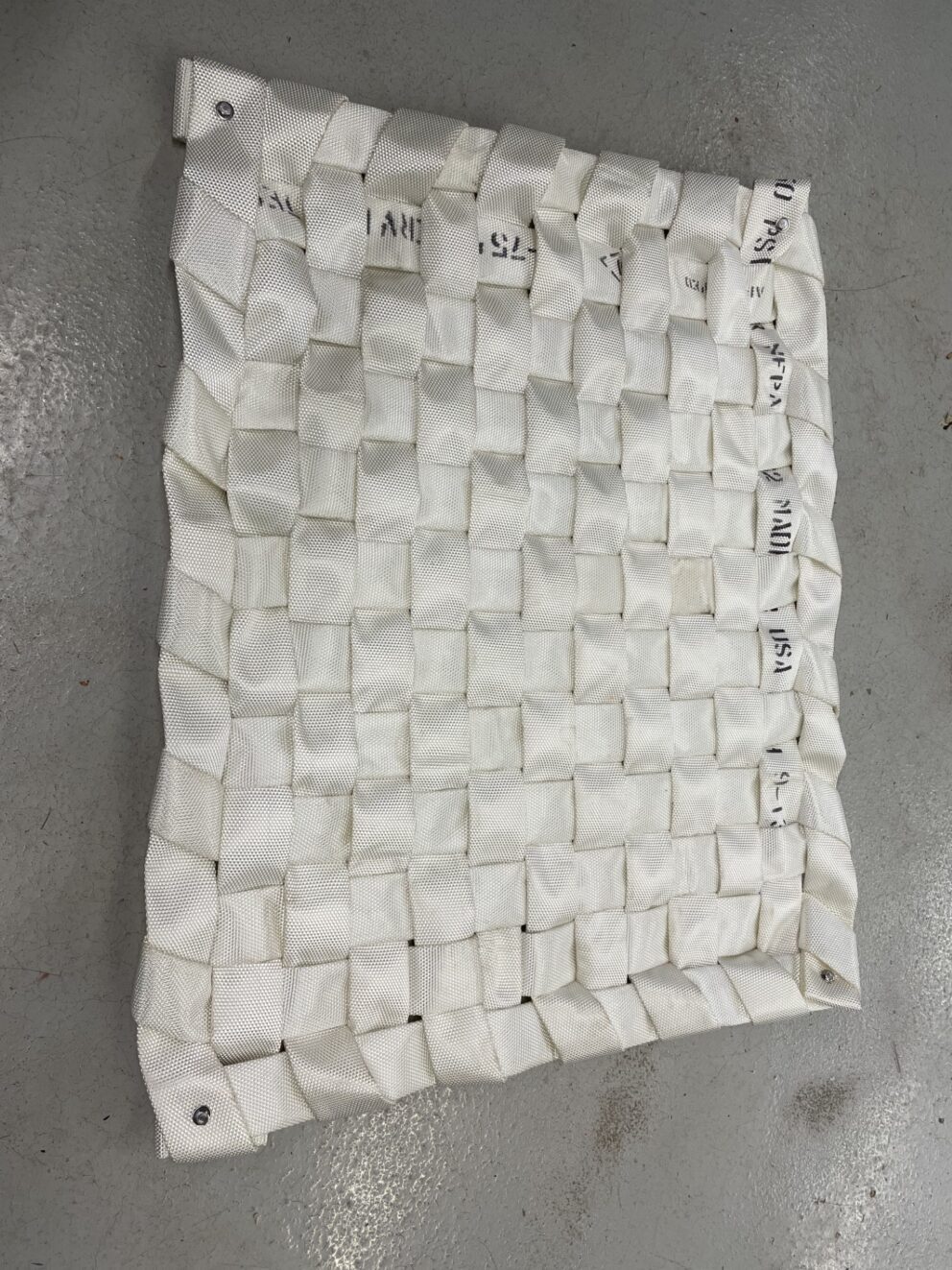
A mat made from woven fire hose. Photo courtesy of Pat Detrie
This requires a knowledge of (or a willingness to learn about) tools and has helped volunteers create a found family that works together for the benefit of the animals. “Such a great group of people I have the privilege of working with,” raves VEG member Susan Andrews, noting that many friendships have developed among the volunteer crew.
Valerie Schrag, who is part of the Tuesday volunteer group, calls herself a “big-time crafter” with a degree in architecture who loves to build things. “Being part of VEG is all the best parts of being back in that world without all the headaches,” she explains. “We get to have so much fun creating and inventing stuff, and we don’t have to worry about any criticism from our animal clients. The best part is constantly learning. I never want to stop learning and every project offers so many opportunities for growth.”

Life-size giraffe enrichment for the rhinos, with VEG members Susan Andrews and Kim Raymond. Photo credit: Theresa Pasquarella, also a VEG member!
The group meets in a workshop located at the behind-the-scenes building. The room is a lively space, full of long tables, tools, and materials. In a hallway, there’s an alcove full of PVC pipes and stands holding different sizes of hoses like the ones firefighters use. Projects in various states of completion, from papier-mache globes to birthday banners celebrating various animals, bring a riot of color to the scene. Volunteers can be seen painting, weaving, talking, laughing, and solving problems with one another. They call this an “amazing place” and create two main types of enrichment here—although every project is different.
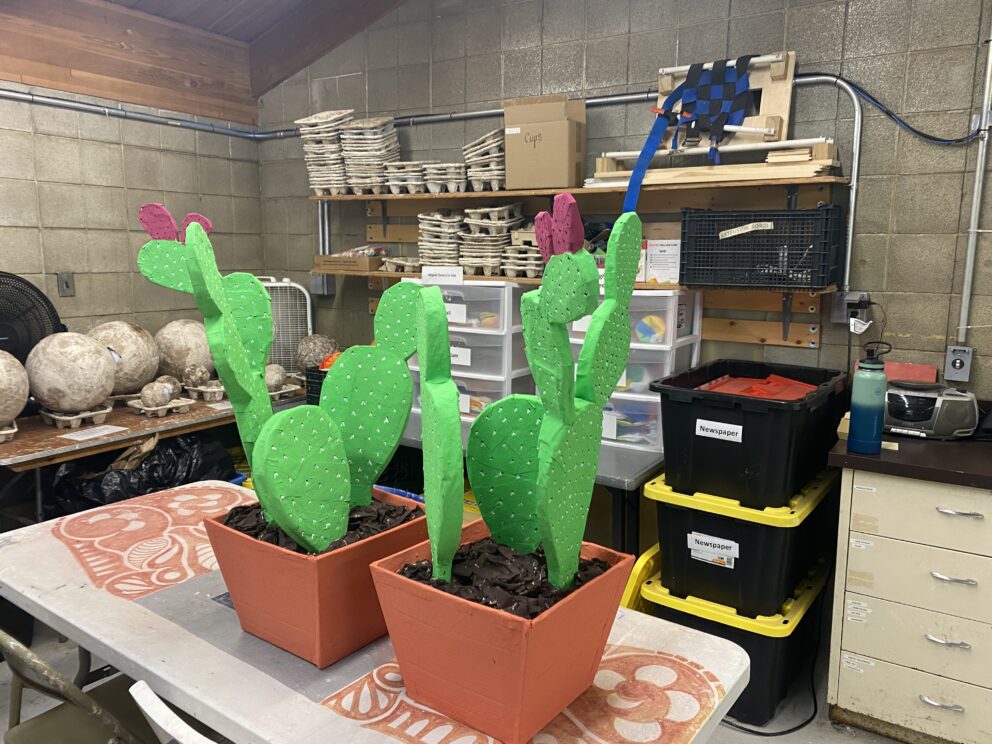
Part of the VEG workspace. Photo credit: Associate Behavioral Husbandry and Enrichment Manager Amanda Barnes
Five-year volunteer Steven Kuh, who says he’s worked on both, explains, “The papier-mache projects involve using paper, cardboard and related materials—plus nontoxic paint—to create balls, animals and other objects that are given to the zoo animals. The animals chew, destroy, and play with the objects, which sometimes contain treats. The ‘tool’ projects usually are made of PVC pipe, fire hose, and other materials. They too are provided to the zoo animals for play, various feeding techniques such as extractive foraging, and other purposes.”
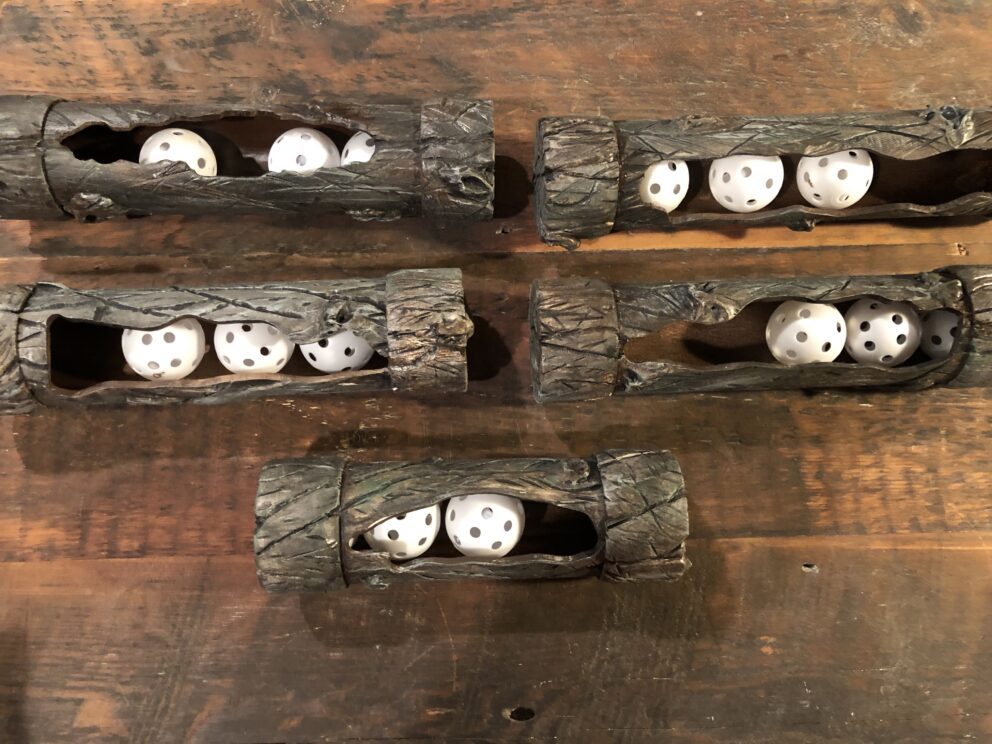
Enrichment made from PVC and designed to blend into animal habitats. Photo courtesy of Pat Detrie
Making a Positive Impact on Zoo Animals
The enrichment these volunteers make are sophisticated, well-crafted, colorful items. Sometimes the VEG crew receives orders for special events, like birthdays or zoo Awareness Days. They may receive whole sets of directions from keepers or just an idea that needs to be imagined from start to finish. These projects can be extremely creative—using inexpensive items like flour, beach balls, pool noodles, and more. And they may come at the last minute, or they might be planned a long time in advance.
Nine-year VEG volunteer Pat Detrie, who has an interest in art and has remodeled several of her own homes, worked on a project that consisted of designing a cover for a new swimming area for turtles at Pritzker Family Children’s Zoo. “This project allowed me to be as creative as possible while also taking into consideration the animals’ needs and the practical requirements of the keepers,” Detrie says.
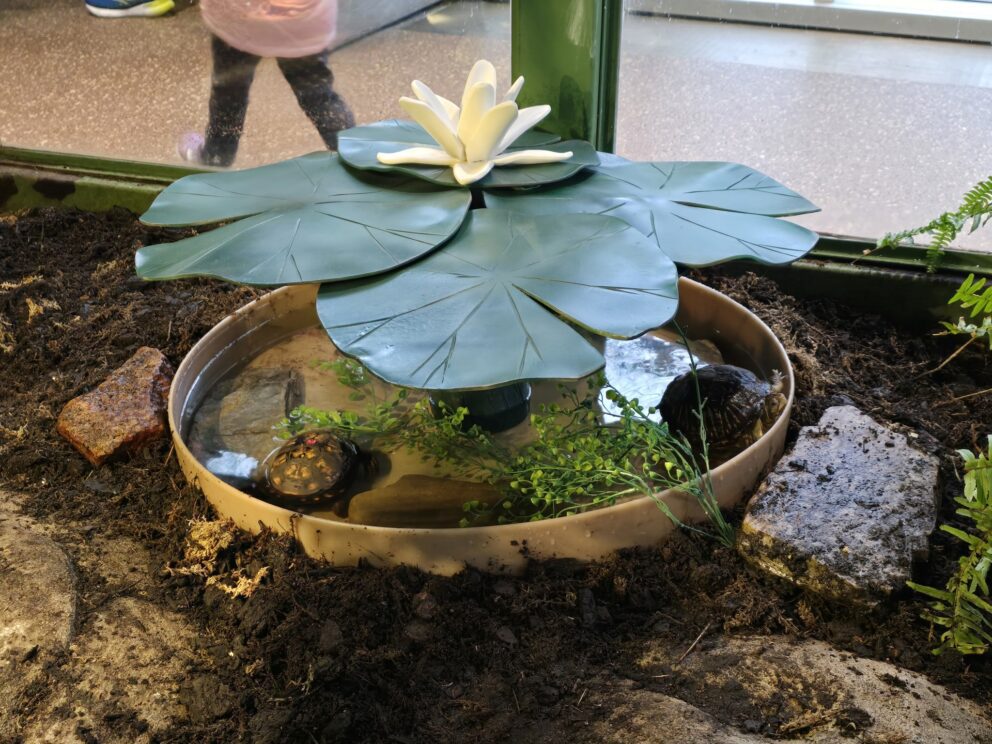
This project helped provide turtles with a shady place to submerge themselves in water. Photo credit: Pritzker Family Children’s Zoo Keeper Annette Van Der Griend
A keeper requested the dish cover so the turtles could do a “soaking” behavior, as their current multiple water options didn’t allow the turtles to go completely underwater. “In nature, box turtles will submerge their shells fully in the water to cool off on a hot day, whereas they may go into more shallow water to actively hunt insects of churn up mud to reveal insects,” Barnes explains. “Both of these behaviors have very different functions, so we want to make sure we are providing the turtles with the opportunity to do both.”
And although it isn’t always predictable how the animals will react to a new element in their habitat, the box turtles started swimming in the covered pool the same day it was installed. Giving them choices helped them express species-specific behaviors and ultimately improved their welfare.
Detrie also created a two-foot-diameter papier-mache globe for the mongooses at Regenstein Small Mammal-Reptile House. It had doors to allow them to enter and included a staircase. “Seeing the mongoose interact with it was incredibly rewarding,” she says.
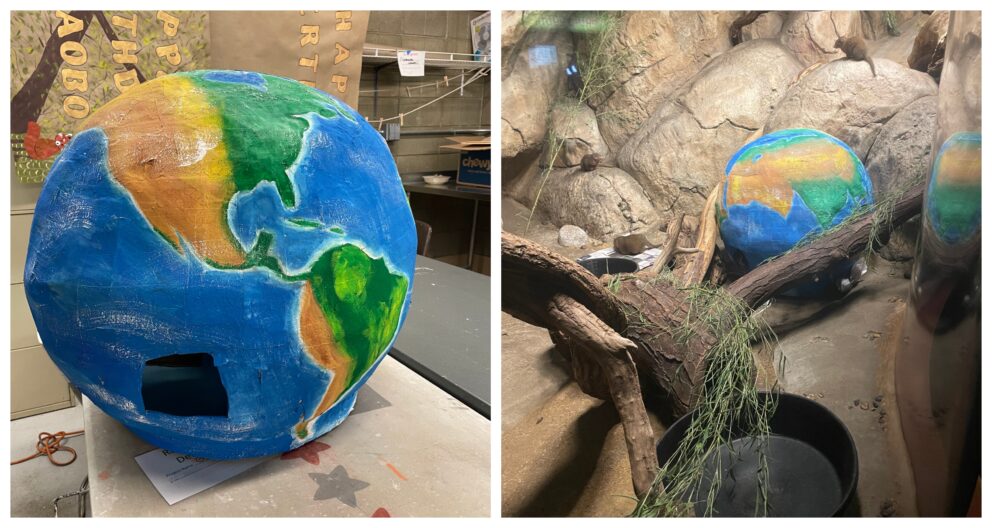
Mongoose enrichment in the shape of a globe. There are stairs inside! Photos courtesy of Pat Detrie
And it goes beyond simple satisfaction—Detrie even says there’s something addictive about creating items for the animals. “Being an animal lover, there’s nothing more fulfilling than creating enrichment items for the animals,” she explains. “It’s incredibly rewarding to see an animal interacting with something you made, whether they’re playing with it, napping on it, or even tearing it apart. I can spend a few weeks building a piñata for a special event like the World Lion Day and the first time you see a lion charge your piñata and tear it apart in a matter of minutes, you’re hooked!”
